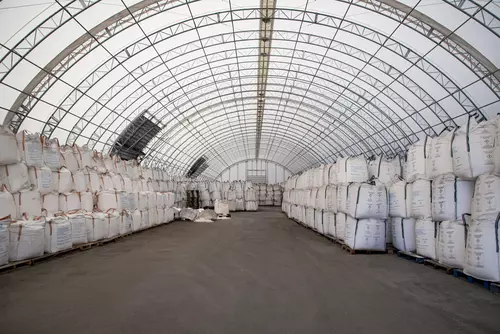Fabric Buildings for Ports & Marinas
Port & marina fabric buildings are the perfect solution for storage at ports and marinas, serving as essential hubs for cargo loading and unloading. Our durable, corrosion-resistant buildings offer expansive, free-span interiors, providing ample storage space and maneuverability. Engineered for long-lasting reliability, MegaDome structures are tailored to your specific needs, ensuring smooth operations and a dry, protected environment for your cargo. Whether your facility is large or small, we work with you to create a structure that meets your requirements and keeps your port running efficiently.
Corrosion-Resistant
Our expert engineers and design specialists leverage years of experience to create durable structures for long-term fertilizer composting. Given the highly corrosive nature of compost, our hot-dip galvanized steel frames are designed to prevent rust and corrosion. This process enhances the zinc coating, ensuring long-term stability and durability for your storage needs.
Low Operational Costs
Compared to traditional building materials, MegaDome’s fabric covers and steel frames offer lower maintenance and operational costs. The natural light reduces the need for artificial lighting, saving on energy expenses.
Bronze Welding
Exclusive - MegaDomes® are designed with superior corrosion resistance. To ensure effective protection, we utilize low-temperature silicone-bronze welding combined with pre-galvanized steel in the manufacturing of our arch frames. This standard provides long-lasting durability and optimal performance in demanding environments.

Applications of port & marina fabric buildings
Fabric buildings offer unmatched versatility & adaptability, making them a popular choice across a wide range of energy, oil and gas industries. Below are some of the most common applications for fabric structures in these settings.
- Cargo Storage
- Boat Storage
- Equipment Storage
- Maintenance Facilities
- Customs and Inspection Areas
- Passenger Terminals
- Warehouse & Storage
- Workshops
Advantages of fabric structures for the marine industry
Fabric structures provide an innovative and practical solution for the marine industry, offering unmatched durability and adaptability in harsh environments. Their corrosion-resistant frames and weatherproof fabric covers are designed to withstand saltwater exposure, high humidity, and strong winds, ensuring long-lasting performance. The clear-span interiors allow for efficient storage and maintenance of boats, marine equipment, and supplies, while the natural light filtration reduces energy costs and enhances visibility. Quick to install and easily customizable, fabric structures are ideal for dry docks, boat repair facilities, and storage warehouses, delivering efficiency and protection for marine operations of any scale.
Moreover, MegaDome port & marina fabric buildings can be expanded or relocated as your needs change, making them a flexible choice for operations facing evolving demands. With a wide array of options—such as advanced ventilation, insulation, or oversized doors—these structures can be tailored to support everything from seasonal boat storage to large-scale marine logistics, ensuring optimal functionality for every project.
Why choose a fabric building for port and marina ?
Fabric buildings are the perfect choice for ports and marinas due to their versatility, durability, and cost-effectiveness. These structures provide ample, unobstructed space to accommodate vessels, equipment, and marine supplies, ensuring seamless operations and organized storage. With customizable options like ventilation systems, reinforced doors, and insulation, they can be tailored to meet the specific requirements of port and marina activities. Additionally, their quick assembly and minimal maintenance make them an economical alternative to traditional buildings. Whether you need a seasonal storage facility or a permanent operations hub, fabric buildings offer the flexibility and resilience essential for the dynamic marine environment.
FAQs about Fabric Buildings for the Marine Industry
Are MegaDome buildings suitable for a port / marina ?
Yes, MegaDome fabric buildings are specifically engineered to perform in ports and marinas. Their corrosion-resistant steel frames and durable, HDPE fabric ensure longevity even when exposed to salt air, humidity, and extreme weather conditions common in ports and marinas. These structures provide reliable protection for both cargo and vessels year-round.
Can port & marina fabric buildings be used for customs inspection or quarantine areas?
Absolutely. MegaDome fabric buildings are ideal for use as customs inspection, quarantine, or security screening areas at ports. Their clear-span interiors allow for flexible layouts and easy movement of personnel, vehicles, and cargo. Structures can be customized with controlled entry points, security features, and insulation to create a safe and efficient environment for sensitive operations.
How quickly can a port or marina building be installed?
Fabric buildings are known for their rapid installation compared to traditional construction. Most MegaDome port or marina structures can be installed in a matter of 2-3 weeks, minimizing downtime and allowing port operations to expand or adapt quickly. Our experienced crews manage the entire process to ensure your building is operational as soon as possible.
Are fabric buildings resistant to wind, salt, and corrosion?
Yes, all MegaDome buildings for port and marina use are designed to withstand high winds, salt exposure, and corrosion. Our level of galvanized steel is perfectly suited for harsh environments. The high-tension fabric is resistant to UV, mold, and saltwater. These features provide long-term durability and reduce maintenance costs for port authorities and marina operators.
Can MegaDome structures for marine sector be relocated or expanded?
One of the key advantages of MegaDome fabric buildings is their modular design. Structures can be relocated to a new site or expanded as your port or marina’s needs evolve. This flexibility allows for scalable storage and maintenance solutions without major reconstruction costs or extended disruptions.
What types of equipment or goods can be stored?
MegaDome fabric buildings are used to store a wide variety of goods and equipment in port and marina settings, including bulk cargo, containers, machinery, vehicles, boats, hazardous materials, and seasonal equipment. Their customizable sizes and access options make them ideal for both short- and long-term storage requirements.
